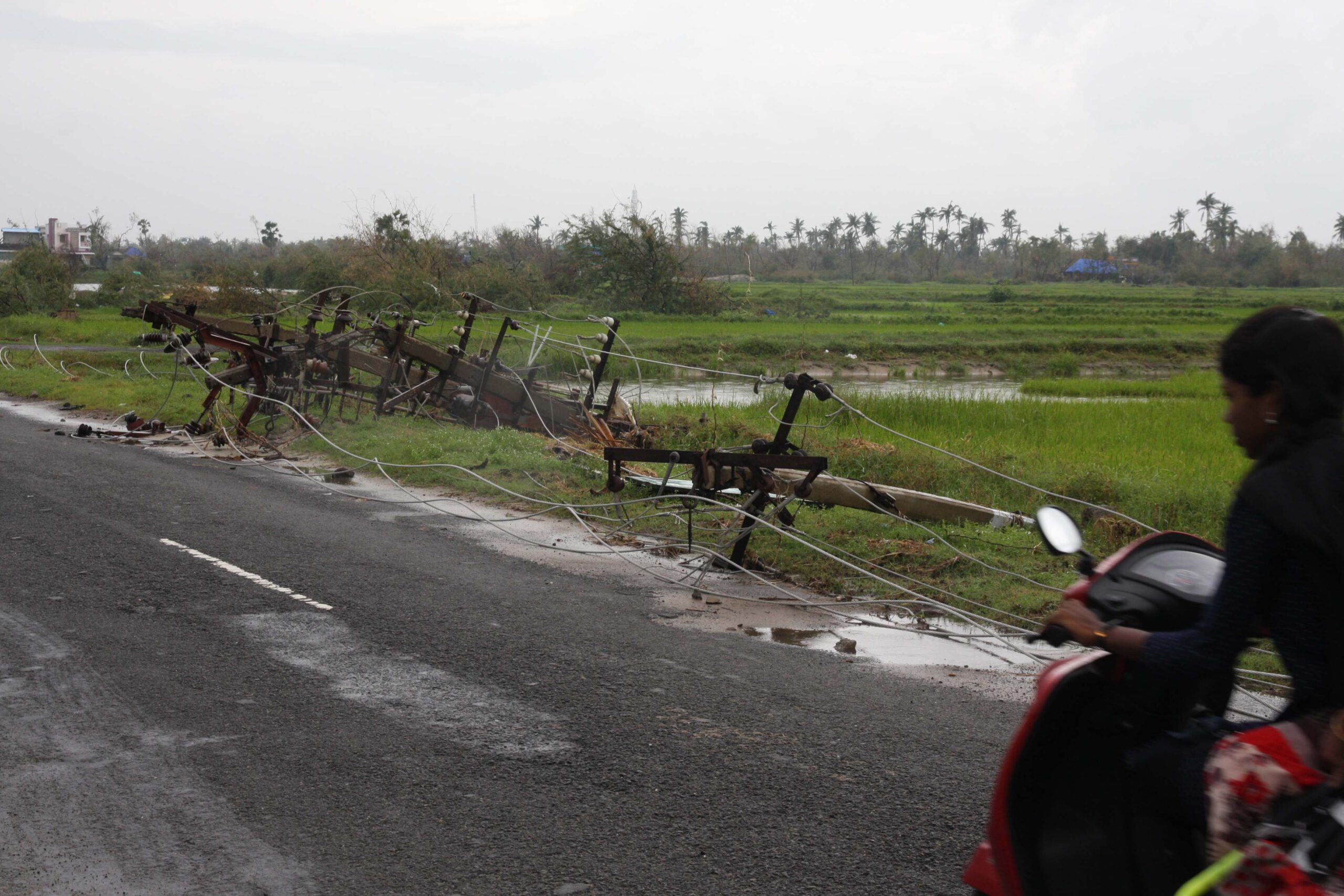The cyclonic system is anticipated to bring wind gusts reaching up to 110 kmph, accompanied by intense, torrential rainfall likely to lash the entire region.
Published Oct 28, 2025 | 1:18 PM ⚊ Updated Oct 28, 2025 | 1:18 PM

Thousands of workers from the electricity and public works departments are tirelessly working to maintain the integrity of critical infrastructure. (File photo/South First)
Synopsis: In the state capital of Amaravati, a Real Time Governance Society (RTGS) is serving as the central nervous system for the entire operation, monitoring the cyclone’s trajectory and on-ground developments in real time. Chief Minister N Chandrababu Naidu has mandated all officials concerned to ensure that the “zero-casualty” mission is executed effectively.
Andhra Pradesh is on the razor’s edge on Tuesday, 28 October, as Cyclone Montha — fragrant flower in the Thai language — advances toward its coastline, projected to make landfall in the vicinity of Kakinada by evening.
The system is anticipated to bring wind gusts reaching up to 110 kmph, accompanied by intense, torrential rainfall likely to lash the entire region.
A comprehensive and multi-layered response has been activated across the state, mobilising entities from government departments to grassroots community organisations. This concerted effort is driven by the administration’s attempt to achieve “zero casualties” in the face of the impending natural disaster.
From the early hours of dawn, a palpable sense of tension gripped the coastal communities, with squally weather providing a foreboding preview of the potential havoc. In Kakinada and adjacent townships, the winds kept howling, signalling the approaching cyclone, even as turbulent waves relentlessly crashed against the shore.
Personnel from the state police forces, alongside dedicated local volunteers and highly trained units of the National Disaster Response Force (NDRF), conducted swift, door-to-door operations in vulnerable villages identified as high-risk, including Uppada, Subbampet, and Mayapatnam. Their mission was to persistently encourage and facilitate the evacuation of residents, with fisherfolk and their families accorded the highest priority for relocation to safer ground.
Off the coast, the waters of the Bay of Bengal surged violently with strong waves eroding protective coastal embankments and directly threatening residential structures built on sandy, unstable stretches. The normally vibrant beaches, which typically host fishing boats and tourists, now lie eerily deserted under a strictly enforced prohibition on all recreational and fishing activities.
By midday, the magnitude of the pre-emptive evacuation operation had become immense. Official reports confirmed that more than 1,238 villages along the coast had been successfully evacuated, with nearly 2,000 relief camps established and fully operational.
The evacuation strategy placed special emphasis on the most vulnerable demographics—pregnant women, the elderly, and young children from low-lying, flood-prone zones—who were systematically transported to hospitals and structurally reinforced cyclone shelters.
To ensure immediate medical response, a network of mobile medical units, boat-based floating clinics, and hundreds of ambulances was deployed across the affected districts.
In the state capital of Amaravati, the Real Time Governance Society (RTGS) served as the central nervous system for the entire operation, monitoring the cyclone’s trajectory and on-ground developments in real time. Chief Minister N Chandrababu Naidu has mandated all officials concerned to ensure that the “zero-casualty” mission is executed effectively.
This directive was continuously echoed by ministers and district collectors in their field briefings, while senior IAS officers were dispatched to the most critically affected districts to assume roles as special officers for direct oversight.
A chain of emergency control rooms has been established throughout the coastal belt, spanning from Srikakulam in the north to Chittoor in the south.
Substantial emergency funds were promptly released to underpin the massive rescue and relief endeavours, securing supply chains for food, potable water, and other essential commodities. All relief camps have been stocked with sufficient provisions, including rice, clean drinking water, blankets, and sanitary kits.
“We have left nothing to chance in our preparations,” a senior official from the Disaster Management Authority said. “Our evacuation operations are proceeding ahead of the anticipated schedule, and thousands of citizens are already secure in shelters.”
Even before the arrival of the cyclone’s core, torrential downpours inundated the districts of Konaseema, East Godavari, and West Godavari. In these perilous conditions, thousands of workers from the electricity and public works departments laboured tirelessly to maintain the integrity of critical infrastructure.
Pre-emptive measures included the reinforcement of over 11,000 electric poles and the securing of approximately 1,000 transformers, with rapid-response teams positioned on standby to immediately address any power outages.
Critical equipment—including water tankers, mobile generators, and bulldozers—was pre-positioned near relief camps and areas susceptible to flooding. Operations to clear fallen trees and barricade damaged roads were already underway.
In certain parts of Chittoor and neighbouring mandals, rising floodwaters severed road access, necessitating immediate traffic diversions by police teams. Officials at major reservoirs carefully managed water inflows to prevent embankment breaches, as local rivers swelled to levels alarmingly close to human settlements.
Within the crowded shelters of Kakinada, families gathered in close-knit groups, sharing food and mobile power banks as the sound of relentless rain drummed on the rooftops. Volunteer organisations worked in coordination with officials to distribute prepared meal packets and manage the flow of essential supplies, while youth groups prepared to initiate extensive cleanup campaigns once the storm passes.
Nevertheless, underlying concerns persisted among the displaced. Many evacuated villagers expressed profound anxiety regarding the structural integrity of their homes, while farmers in low-lying regions such as Machilipatnam looked on helplessly as floodwaters submerged their agricultural fields, clinging to the hope of prompt government compensation once the cyclone subsides.
The Indian Meteorological Department (IMD) has maintained a red alert for the entire coastal stretch from Nellore to Srikakulam, forecasting exceptionally heavy rainfall and severe gale-force winds. Officials have repeatedly urged the public to remain indoors, adhere strictly to all evacuation orders, and rigorously avoid any proximity to water bodies. The ensuing hours will serve as the ultimate test of the state’s disaster preparedness, the robustness of its infrastructure.
(Edited by Majnu Babu).
